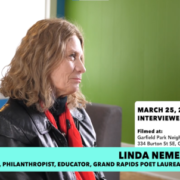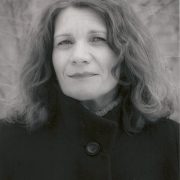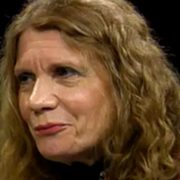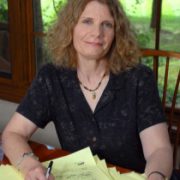10 Questions for Linda Nemec Foster
Linda Nemec Foster graduated magna cum laude from Aquinas College and received her M.F.A. from Goddard College. From 1980-2002, she taught poetry workshops for the Michigan Creative-Writers-in-Schools Program.
Foster is the author of nine collections of poetry: A History of the Body (Coffee House Press, 1987); A Modern Fairy Tale: The Baba Yaga Poems (Ridgeway Press, 1992); Trying to Balance the Heart (Sun Dog Press, 1993); Living in the Fire Nest (Ridgeway Press, 1996) which was a finalist for the Poet’s Prize; Contemplating the Heavens (Ridgeway Press, 2001); Amber Necklace from Gdansk (Louisiana State University Press, 2001) which was a finalist for the Ohioana Book Award in Poetry; Listen to the Landscape (Eerdmans Publishing, 2006) which was short-listed for the Michigan Notable Book Award; Ten Songs from Bulgaria (Cervena Barva Press, 2008); and Talking Diamonds (New Issues Press, 2009) which was a finalist for ForeWord Magazine’s 2010 Book of the Year in Poetry.
Over 300 of her poems have appeared in various magazines and journals. In 1997 she founded the Contemporary Writers Series (CWS) at Aquinas College and currently is a member of the Series’ programming committee. You can visit her at: http://www.lindanemecfoster.com/
GER: Tell us about your latest release Talking Diamonds and the inspiration behind the development of the collection.
LNF: Talking Diamonds was published in 2009 by New Issues Poetry & Prose (sponsored by Western Michigan University) and was the culmination of six years of writing the poems and sequencing the collection. During most of that time, the title was different but the theme of the manuscript was always the same: death, loss, faith, doubt, and the strong redemptive effect of art on the human psyche. From the first poem, “The Field Behind the Dying Father’s House,” to the last, “Trinity,” there is a progression of imagery and metaphor that speaks to the life journeys we all experience. The book is divided into three parts: the first section deals with death and loss; the second part deals with how the landscapes we live in influence our sense of transitions; and the final section is devoted to ekphrastic poems–all the poems are inspired by visual art. During the time I was drafting and revising the manuscript, I was dealing with a number of losses in my life–including the declining health of my father. He died two months before the book was published. That experience (and others) really influenced my creative process and the poems I was writing at the time. When I started sending the collection out for publication, I actually thought that no editor would be interested because of its somber tone but I couldn’t (and wouldn’t) “lighten it up.” When New Issues Press accepted the manuscript in the spring of 2008, editor William Olsen was impressed with its distinctive voice and lack of guile: in other words, I was correct to follow my instincts and not try to “re-work” the poems. Olsen also saw the collection as being more about transformation than strictly loss. He suggested the book’s title from one of the poems that reflected this theme and it was “Talking Diamonds.” I’m indebted to his careful and diligent reading of my work.
GER: You have a long history of conducting workshops for poets. What are the benefits to the poets who attend and the benefits to you?
LNF: I’ve taught creative writing workshops for over 30 years. From 1980-2002, I was very involved with the Creative-Writers-in-the-Schools sponsored by the Michigan Council for the Arts and Cultural Affairs. This program placed poets and writers in K-12 schools (both public and private) throughout the state of Michigan in residencies that lasted anywhere from several days to several months. On the average, I would do 3-5 residencies in an academic year. I loved interacting with the students (especially in grades 4-12); their enthusiasm and interest were infectious and always inspired my own work in the process. The most memorable workshop I conducted during those years was in the spring of 1996. I spent a week at an elementary school in Grand Rapids (with 3rd and 4th graders) where most of the student population were either Hispanic or African-American. In the middle of that week, there was an after-school shooting in the playground. Miraculously, no one was killed or seriously injured but it did “shake-up” the city. This incident really gave my students in the poetry workshops a sense of purpose when they came to school the next day. They all wanted to write about the incident; I channeled that desire to focus not on guns and violence but on their sense of identity in the community. It was such a positive experience that the Grand Rapids Press did a major two-page article on the workshops. I’ve also taught on the college level as an adjunct professor and guest lecturer on quite a number of campuses in the Midwest and elsewhere. And I’ve lead community workshops for adults in art centers, libraries, museums, and galleries. The most satisfying was a Master Level class I taught in 1999 at the Detroit Institute of the Arts: I was awarded a teaching fellowship by the National Writer’s Voice (sponsored by their NYC office) to conduct an advanced poetry workshop. The theme of the workshop was ekphrastic poetry and I used the exhibits at the Institute as springboards to assign the poetry exercises. There were only nine participants–all women–who had gone through a competitive submission process to be accepted for the program. As the semester progressed, I realized they were all fine writers who wrote poetry that inspired my own writing–every exercise I gave them, I also did. Several of these former students have gone on to win awards and publish books. Nothing is more satisfying for a teacher.
GER: You have received a number of awards and grants. How important was it to your writing career to have received such recognition?
LNF: When I was at Goddard College studying for my MFA in creative writing, one of my teachers and mentors Stephen Dobyns had a discussion with me about awards, grants, etc. His advice was not to be obsessed with winning recognition–just keep focused on the work. But I have to admit, it is a wonderful feeling to get accolades for your poetry. My books have been finalists for the Ohio Book Award (Amber Necklace from Gdansk), ForeWord Magazine’s Book of the Year (Talking Diamonds), Michigan Notable Book Award (Listen to the Landscape), and the Poet’s Prize from the Roerich Museum (Living in the Fire Nest). My work has also received awards from the Arts Foundation of Michigan, ArtServe Michigan, the National Writer’s Voice, and the Academy of American Poets, among others. I was also selected to be the first Poet Laureate of Grand Rapids, Michigan. Probably the most notable recognition was winning the Creative Arts Award from the Polish American Historical Association. The award was presented to me at a ceremony at the Polish Embassy in Washington, D.C. The fact that all four of my grandparents immigrated to America from Poland made this award particularly significant. I felt honored and humbled–as if the legacy of my family was also recognized. Obviously, it is wonderful to have these kinds of affirmations for my poetry. But, after all is said and done, Dobyns was right. It really is the work that ultimately matters. Without it, there really can’t be anything else.
GER: A large body of your work has been published. Where do you get the inspiration for your poems? What is your process of crafting each one?
LNF: Another teacher of mine, Ken Mikolowski at Wayne State University, once told the class that “anything can be poetry, not everything is.” In other words, anything you experience can become the inspiration for a poem. The difficult work is transforming that experience–with a unique voice and vision–into a poem that can be accessible to the reader/listener yet can maintain a palpable mystery in its core. I have gained my inspiration from family tragedies to strangers’ random conversations I overhear in restaurants, from crass tabloid headlines to extraordinary works of art. Anything is possible and everything should be on the table. Regarding my process, when I write a poem I always start by writing in longhand. I go through 5-10 drafts on yellow legal notepads before I continue to draft and revise on the computer. That’s when I see the shape of the poem as the line breaks, stanza breaks, and general form can be visualized. In my process, the content comes first and then the form. But both have to work as seamless, intertwined entities for a poem to truly become a unique vision. It’s the ultimate balancing act. “Without a net,” as another mentor joked.
GER: Tell us about your collection Amber Necklace and the inspiration behind the collection.
LNF: Amber Necklace from Gdansk was published in 2001 by Louisiana State University Press. This full-length collection of poems was inspired by my Polish-American heritage and the first visit to my family’s homeland in 1996. The book reflects on the immigrant experiences of my grandparents–an experience of loss and discovery, of ambivalence and pride, of deep tragedy and redemption. My own ethnicity as the daughter of second-generation immigrants from Poland is colored by America’s somewhat disinterested view of the “other” Europe–only recently emerged from history’s dark shadow–and of a country that for over a hundred years did not exist as a political entity on a map. In the book’s opening poem, “The Awkward Young Girl Approaching You,” I struggle with this sense of ethnic identity: “Who will speak for the dispossessed,/those who come from nowhere,/whose birthplace cannot be found/on any map…?” My attempts to reclaim an ethnic heritage, to search for myself in the mirror of my family’s history, resonate throughout the poems. Divided into four parts and employing a variety of styles and forms, the collection moves from lyric childhood memories and descriptions of immigrant life to prose poems that interweave the mythic past with the present. Amber Necklace from Gdansk captures the sense of loss that can still permeate Poland–from Chopin’s self-exile, to the silence of rain, to the overwhelming horror of the Holocaust–and concludes with a group of poems that reveals resilience in the face of a haunted past and an iconoclastic present. I have been back to visit Poland six times since 1996, but that first trip was truly a significant touchstone in my life and an amazing wellspring of inspiration for my writing. It is my hope this book is a testament to the land, history, and culture of my ancestors.
GER: What poets do you read and who are your favorites?
LNF: I have a long list of poets who are my favorites: Walt Whitman, Emily Dickinson, Dylan Thomas, William Shakespeare, Rainer Maria Rilke, Lisel Mueller, Seamus Heaney, Phil Levine, Stephen Dobyns, Ellen Bryant Voigt, Heather McHugh, Li-Young Lee, Linda Pastan, Marilyn Nelson, Linda Hogan, Czeslaw Milosz, Zbigniew Herbert, Wislawa Szymborska, Adam Zagajewski. The list can go on and on. Extraordinary, rich, and diverse voices that I read again and again to make some sense of this world and my place in it.
GER: What advice would you give emerging poets on the submission process?
LNF: Have a thick skin! The submission process is very competitive. When you consider that some magazines and journals accept less than 5% of the work submitted, you can understand how many poets compare the whole process to a lottery system. Book publishing (and I’m not talking about self-publishing) is also challenging. Very good resources for submissions are the regular columns in Poets & Writers Magazine and the annual publication of The International Directory of Little Magazines and Small Presses. The latter resource is excellent for emerging poets since it gives them a good sense of editors and who, what, and why they publish. In the submission process, patience and persistence are sometimes just as important as talent. It demands time and energy–a different kind of energy that is used in the creative process–but you just have to stick with it. Do your homework. Read and research those publications you’d like to submit to. If you’re just starting out, don’t submit work to The New Yorker. Concentrate on those publications that are open to and encourage new and emerging poets.
GER: How important is it to you as a poet to share your work with audiences at poetry readings?
LNF: Let’s be honest: being a poet can be a lonely profession. The creating, crafting, and revising of poems demand concentration, time, energy, and discipline. For me, it is very important to “get out into the world” and share my work with audiences on a regular basis. Some poets don’t like to give readings and/or are not very good at public presentations. I’ve heard some famous poets give awkward, poor readings and some relatively unknown poets give wonderful readings. The bottom line is that a poem should be strong on the page and in the voice. After all, poetry started as a purely oral tradition long before the invention of paper, the letterpress, or the laptop.
GER: Tell us about the poetry scene in Michigan in particular various reading series.
LNF: There are several very fine reading series in Michigan. The one that I am most familiar with is the Contemporary Writers Series at Aquinas College in Grand Rapids. I founded the Series (along with my husband) in 1997 and we have hosted some of the finest poets and writers: Seamus Heaney, Michael Ondaatje, Peter Carey, Li-Young Lee, Scott Turow, Thomas Lynch, Lisel Mueller, Maxine Kumin, Linda Pastan, Linda Hogan, Joy Harjo, Quincy Troupe, David Mura, Clarence Major, etc. Every academic year, we bring in 4 authors–two in the fall semester and two in the spring–and our audience averages around 200 per event. Seamus Heaney broke the attendance record in May of 2006 when he read for over 640 poetry lovers. It was a memorable night, especially when he told me after his reading that he thought the Contemporary Writers Series was one of the best reading series in the country. Here is a link to the CWS website. http://www.aquinas.edu/cw/index.html I’d like to list five other series that deserve mention: the Jack Ridl Visiting Writers Series at Hope College (Holland); the Gwen Frostic Reading Series at Western Michigan University (Kalamazoo); the program coordinated by Robert Fanning at Central Michigan University (Mt. Pleasant); the Hopwood Reading Series at the University of Michigan (Ann Arbor); and the wonderful events hosted and organized by M.L. Liebler that take place throughout the Detroit area. Last month, Poets & Writers invited me to write an article for their blog about one of the events in Detroit. Here’s the link. http://www.pw.org/content/linda_nemec_foster_ All of these programs attest to a lively and thriving poetry scene.
GER: What projects are you currently working on?
LNF:Earlier this year, I finished a collaboration with Hungarian musician Laszlo Slomovits. This project had its beginnings when I first viewed the work of photographer Jacko Vassilev. His portfolio, “The Dance of Zlatio Zlatev,” appeared in Harper’s Magazine and gave visual testimony to the impoverished and marginalized people of Eastern Europe. Vassilev’s haunting portraits inspired me to write a sequence of poems, Ten Songs from Bulgaria, that was published by Cervena Barva Press in 2008. The next step in this process occurred in 2011 when Slomovits read the chapbook and was immediately drawn to the poems as lyrics for original songs. He began composing ten pieces to correspond to the ten poems: our CD, Cry of Freedom, is the result of this partnership of art, poetry, and music. It was released in 2013. Michigan Public Radio (an affiliate of NPR) invited us into the studio for an interview. Here’s the link. http://michiganradio.org/post/bulgarian-photography-and-michigan-poetry-inspire-album Also, I am currently working on a new manuscript of prose poems, Fragments.
Originally Published by Fox Chase Review, click here to view article.





